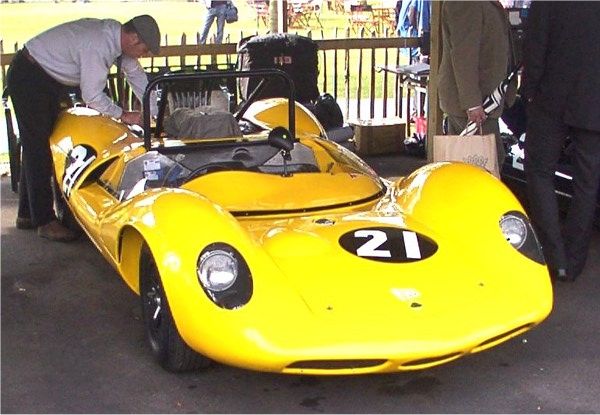Description
The Lotus 30, introduced in 1964, was one of Colin Chapman’s most ambitious and controversial creations. Conceived as a large-displacement sports-racing car designed to take on the new generation of powerful Can-Am and European endurance machines, the 30 represented a radical attempt to scale up Lotus’s lightweight design philosophy to handle enormous power. It was the company’s first true big-engine sports car, intended to combine the agility and innovation of the smaller Lotus 23B with the brute force of a 4.7-litre Ford V8. However, while the 30 was breathtakingly fast and visually striking, it also revealed the limits of Chapman’s lightweight approach when applied to such high torque and power — a car of great promise that became equally famous for its brilliance and its flaws.
The Lotus 30 was developed as a Group 7 sports-racer to compete in international events such as the Guards Trophy, the British Racing Drivers’ Club races, and the early American sports-car series that would evolve into Can-Am. At its heart was a mid-mounted Ford 289 cubic-inch (4.7-litre) V8 engine, the same unit used in the Ford GT40 and Shelby Cobra, producing around 350 to 380 horsepower in standard form and capable of much more in tuned versions. In a car weighing just under 600 kilograms, this gave explosive acceleration — 0–60 mph in well under 4 seconds and a top speed approaching 180 mph, depending on gearing.
The chassis design was one of the most innovative yet controversial aspects of the car. Chapman chose not to use a conventional tubular spaceframe or a full monocoque, but rather a complex aluminium “backbone” chassis — an enlarged version of the type that had served so well in the smaller Lotus Elan and earlier racing cars. This consisted of two deep aluminium box sections running longitudinally, connected by bulkheads that also served as fuel tanks. It was light and compact, but it lacked the torsional rigidity needed to cope with the immense torque and cornering loads produced by the large V8 engine and wide racing tyres. As a result, the chassis flexed under heavy braking and high cornering forces, unsettling the handling and sometimes leading to mechanical failures.
Suspension was fully independent, with unequal-length wishbones and coil springs at the front and a reversed lower wishbone setup at the rear with twin radius arms and outboard coil-over dampers. The brakes were large Girling ventilated discs on all four wheels, and the steering was a rack-and-pinion system derived from Lotus’s Formula One cars. The car’s mechanical layout was compact and elegant, and on paper it promised extraordinary performance. However, in practice, the chassis flexibility made the car unpredictable on the limit, and drivers often complained that it was fast but frightening to drive at full pace.
The bodywork of the Lotus 30 was designed by Ron Hickman and constructed in lightweight fibreglass, giving the car a low, wide, and muscular appearance. It was one of the most beautiful Lotus designs of the 1960s, with smooth, flowing lines and a long, sleek profile that exuded power and speed. The wide stance and low centre of gravity made it look every inch a modern sports prototype. The car featured faired-in headlights, a large wraparound windscreen, and prominent rear haunches covering wide racing tyres — all features that contributed to its striking aesthetic appeal.
The Lotus 30 made its debut at the 1964 Brands Hatch Guards Trophy, driven by Jim Clark, who initially found it exceptionally quick but difficult to handle at the limits of adhesion. The car showed immense straight-line performance, easily outpacing smaller rivals, but handling issues and structural fatigue soon became apparent. Despite ongoing development — including strengthening of the chassis and revisions to suspension geometry — the problems persisted, and the 30 gained a reputation for being as dangerous as it was fast. Clark himself described it as “a wonderful engine in a treacherous frame.”
Lotus attempted to improve the concept further with the Lotus 40, introduced in 1965, which featured a larger 5.0-litre Ford V8 and further chassis reinforcement, but even this could not fully resolve the car’s underlying structural limitations. The 30 and 40 were extremely quick in a straight line, but they remained unpredictable under heavy load, particularly on rough circuits where flex and instability made them difficult to control.
Although the Lotus 30 never achieved major international success, it remains one of the most fascinating and technically daring cars in Lotus history. It represented Chapman’s determination to innovate and to apply his lightweight principles to a new class of high-powered racing cars. The lessons learned from its failure directly influenced the design of later Lotus models, especially the adoption of fully stressed monocoque structures for both Formula One and sports-car applications.
Today, the Lotus 30 is remembered as a car of contradictions — stunningly beautiful, brutally fast, yet notoriously flawed. Its sleek fibreglass body and thunderous Ford V8 made it one of the most dramatic Lotus cars ever built, while its engineering shortcomings served as a turning point in Chapman’s design philosophy. Only about thirty Lotus 30s were produced, and surviving examples are now rare and valuable, cherished as both technical curiosities and spectacular reminders of Lotus’s most adventurous era.
In historical context, the Lotus 30 stands as a symbol of Chapman’s boldness — an ambitious attempt to stretch the boundaries of design and performance. Though it fell short of its promise on the track, it played a crucial role in Lotus’s evolution, bridging the gap between the lightweight sports-racers of the 1950s and the more advanced, monocoque-based designs that would define the company’s racing success in the years to come.


